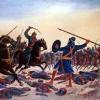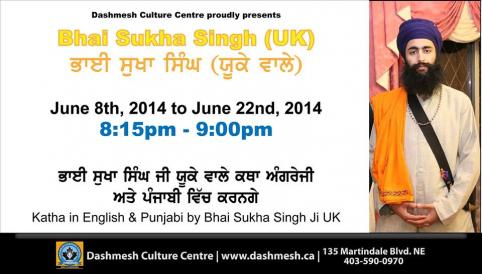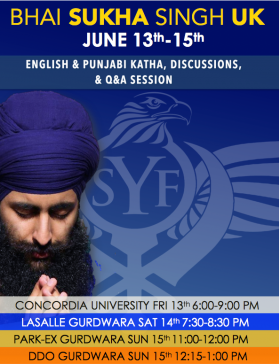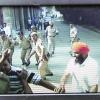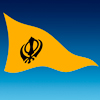Search the Community
Showing results for tags 'canada'.
-
ਕਹਤੇਪਵਿਤ੍ਰਸੁਣਤੇਸਭਿਧੰਨੁਲਿਖਤੀਂਕੁਲੁਤਾਰਿਆਜੀਉ ॥ Those who chant are sanctified. All those who listen are blessed, and those who write save their ancestors. Ang 81, Sri Guru Granth Sahib Jee The art of writing Gurbani has vanished from the Sikh households. We are reliant upon the printing firms to publish Gurbani for us. Needless to mention, this has led to desecration of our scriptures in the recent years. The pristine tradition of writing the holy text was started and prescribed by the Gurus themselves. Guru Arjun Dev Ji had Bhai Gurdas Ji write the first Adi Granth, while many Gursikhs present in the attendance of Guru Gobind Singh Ji also penned Gurbani. These Gursikhs included Baba Deep Singh Ji and Bhai Mani Singh Ji. No wonder, they were amazingly enlightened souls! The objective of the workshop is to introduce our youth to the beauty of writing Gurbani with our own hands and instruments. There are only ten spaces availbale for this event. Please register using this link https://goo.gl/forms/xWza2b52GezAfhNy2. Specific guidelines for the prepartion of the workshop will be emailed to the registered candidates. N.B. Please note basic familarity with Punjabi language is required for this activity. Gurbani Calligraphy - A Workshop on Writing Gurbani InterestedGoing Invite Public · Hosted by McGill Sikh Students' Association Place : HSSL - Cyberthèque Pod 1 Redpath Library Building, 3459 Rue McTavish clock 8 November at 18:00–19:30 EST Next Week About McGill Sikh Students' Association McGill Sikh Students' Association Community The McGill Sikh Students' Association is a club under SSMU that aims to increase knowledge about Sikhism. Email us at mcgill.sikhs@gmail.com
-
A man has been charged with assault after police say he ripped a turban off another man’s head in downtown Toronto. The alleged incident happened at Yonge-Dundas Square at 5:45 p.m. on Wednesday. Police say a 35-year-old man was sitting in the square with his family when a man approached the victim from behind and tore off his turban. The suspect proceeded to make derogatory comments and fled the scene. People in the area who witnessed what happened called police. Robin Kelly Skani, 31, of no fixed address, appeared in court on Thursday. He is being held until his bail hearing on Friday. Video is here - http://www.citynews.ca/2016/10/20/turban-ripped-off-mans-head-yonge-dundas-square/
-
Elementary teachers Summary Information: Employer: Khalsa School Surrey Position Type: Teaching Categories: Elementary Elementary (Primary) Elementary (Intermediate) School / Org: Khalsa School Location: Surrey, British Columbia FTE: FTE No. of Positions: 6 Salary: $4075/month Posting Date: Saturday, 09 July 2016 Closing Date: Tuesday, 26 July 2016 Details: Khalsa School is a faith-based independent school system composed of over 2700 students with four campuses in Surrey and one in Mission serving students from Kg Grade 12. We offer a holistic approach and our students excel academically, socially and in sports. We are currently seeking an enthusiastic teachers to join our friendly and supportive team starting in Sept. 2016. Qualifications: A valid BC Teaching Certificate Training or experience in English Language Learners is an asset A caring nature and an attitude of continuous self-improvement A strong understanding of the developmental needs of students Superior communication and interpersonal skills Please provide your cover letter, resume, evaluation reports (practicum or employment) and contact information for three professional references by email to Ms. Bajwa at jbajwa@khalsaschool.ca Source - http://jobsearch.educationcanada.com/index.phtml?a=v&j=161979
-
Certified (OCT) Teachers (Grades 4 - 10) Khalsa Community School Brampton - Brampton, ON Khalsa Community School Brampton a private religious school is seeking certified (OCT) teachers for full time positions - Core French (Grades 4 - 10), Junior Intermediate (Grades 4 - 8), Math Science and Business Technology (Grades 6 - 10). Source - http://ca.indeed.com/cmp/Khalsa-Community-School,-Brampton/jobs/Certified-960c59cdf199b448?q=Khalsa Grade 2 Teacher, Science Teacher, Punjabi Teacher Khalsa School Malton (Elementary, Secondary, IB Candidate School) - Malton, ON 3 Positions Open at Khalsa School Malton Source - http://ca.indeed.com/cmp/Khalsa-School-Malton-(Elementary,-Secondary,-IB-Candidate-School)/jobs/Grade-Teacher-30c4b9f27b8ac09e
-
Canada apologizes for 1914 rejection of Asian migrant ship Prime Minister Justin Trudeau formally apologizes, Wednesday, May 18, 2016, in the House of Commons on Parliament Hill in Ottawa, for a 1914 Canadian government decision that barred most of the passengers of the Komagata Maru from entering the country. Canadian officials refused to allow the Indians in, even though they were British subjects just like every other Canadian of the time. The chartered vessel was carrying 376 Indian passengers, nearly all of them Sikhs, bound for what they thought would be a new life in Canada. (Adrian Wyld/The Canadian Press via AP) The Associated Press By ROB GILLIES Posted: May. 18, 2016 8:00 am Updated: May. 18, 2016 9:38 pm TORONTO (AP) Canadian Prime Minister Justin Trudeau apologized in Parliament on Wednesday for a government decision in 1914 to turn away a ship carrying hundreds of South Asian immigrants. The Komagata Maru from Hong Kong arrived off Vancouver only to have almost all of its 376 passengers, nearly all of them Sikhs from India, denied entry due to immigration laws at the time. The passengers were hoping to challenge Canadian immigration law, which refused entry to any Indians who had not arrived in Canada via a continuous journey from the Indian mainland nearly impossible at the time. The law was seen as a measure to stymie Indian arrivals. Officials refused to allow the Indians in, even though they were British subjects just like every other Canadian of the time. After 20 passengers who had previously lived in Canada were allowed to disembark, the ship was turned away. The ship was eventually sent to Calcutta, and least 19 people were killed in a skirmish with British soldiers. Others were jailed. "Canada's government was, without question, responsible for the laws that prevented these passengers from immigrating peacefully and securely," Trudeau said. "For that, and for every regrettable consequence that followed, we are sorry." Opposition leaders also apologized. New Democrat leader Thomas Mulcair called it "racism, plain and simple." A spectator in the public gallery hollered out a Punjabi slogan that signals happiness after Trudeau spoke. Former prime minister Stephen Harper apologized at an event in British Columbia in 2008, but members of the Sikh community have long said an apology should be offered formally in Parliament. There are more than a million Canadians of South Asian descent. Trudeau had pledged to make an apology during his election campaign last year. He noted in Parliament on Wednesday that Canada's current defense minister, Harjit Sajjan, once commanded the reserve regiment that turned back the Komagata Maru and thanked him for helping the Komagata Maru incident get national attention. "Before entering political life, the minister was the commanding officer of the British Columbia Regiment Duke of Connaught's Own the same regiment that once forced out the Komagata Maru," Trudeau said to applause. "A century ago, the minister's family might well have been turned away from Canada. Today, the minister sits beside us, here, in this House." Sajjan tweeted that he was humbled and grateful and he thanked Trudeau.
- 29 replies
-
1
-
- canada
- komagata maru
-
(and 5 more)
Tagged with:
-
Event Date/Time: February 26, 2016 - 2:30pm Location: Gurdwara Guru Nanak Darbar, Montreal Canada Contact Name: S. Surjit Singh Contact Email: dukhbhanjanteranaammissionc@gmail.com Event Website: www.dukhbhanjanteranaam.com Dukh Rog Nivaran Camp:- Gurdwara Guru Nanak Darbar 7801 Rue Cordner, LaSalle, QC H8N 2X2 Phone: 514-595-1881 Dates:- 27 Feb. to March 1 Saturday to Tuesday: 12:30pm to 6:30pm For more information please call Surjit Sigh 514-977-8624 or visit www.dukhbhanjanteranaam.com Source - http://www.sikhnet.com/events/dukh-rog-nivaran-camp
-
Charity Basketball Tournament Venue - Khalsa School Calgary, 245228 Range Road 284, Calgary, Canada TIME - Sat Jan 30 2016 at 08:00 am Source - http://allevents.in/calgary/hoops-for-healing-basketball-tournament/400031106874129
-
I am just wondering if we have any Sikhs from Canada on this forum? If not, then is there any other Sikh forum that has a lot of Canadian Sikh users that talk about issues that affect Canadian Sikh community? It seems like this forum is run by British Sikhs who talking about issues that mainly affect their community and Islam (I guess Muslims taking over Europe is bit of an issue for them?).
-
(April 17, 2015)—Moninder Singh, a well-respected Sikh youth activist was arrested earlier today during a protest outside Ross Street Gurdwara in Vancouver. A number of Sikh youth, along with representative of various organizations arrived outside the Gurdwara to protest the arrival of Modi for his role in massacres of Muslims in Gujarat. Modi Government is also responsible for carrying out attacks on various other minorities in India. Jakara Movement, a Sikh Youth organization stated that Moninder Singh was arrested for exercising freedom of speech. Canadian police also threatened to arrest others who were at the Gurdwara. Moninder Singh was asked to leave by the police, however he refused and continued to protest peacefully when he was arrested. Sangat members were denied entry to the Gurdwara by the police. “We are being asked to leave the premises. We are denying, we are rejecting the police telling us to move. They are gearing up to push us out,” said a youth outside the Ross Street Gurdwara. Source http://www.sikh24.com/2015/04/17/breaking-canadian-police-arrests-sikh-youth-leader-during-peaceful-protest-against-narendra-modi/#.VTCkhPnF9K0 Extra videos from the Modi protest at Candian Gurdwara:https://www.youtube.com/user/jakara/videos
-
ਵਾਹਿਗੁਰੂਜੀਕਾਖਾਲਸਾ॥ ਵਾਹਿਗੁਰੂਜੀਕੀਫਤਿਹ॥ Visa Denial to Red Carpet for Narendra Modi - A downward shift in Canadian policy and ethics The Prime Minister of India, Narendra Modi, played a decisive role to teach a lesson to the greater Muslim community during the anti Muslim riots in Gujrat in 2002. At that time a senior member of the Gujrat Intelligence Bureau Mr. Sanjiv Bhatt filed an affidavit that CM Modi told all authorities to allow the Hindu community to vent out their anger at the Muslim population. This all took place in a high profile security meeting. “A senior police officer's sworn statement to India's Supreme Court alleges that Gujarat Chief Minister Narendra Modi deliberately allowed anti-Muslim riots in the state” - BBC. This was one of the reasons that the Canada’s Immigration and Refugee Protection Act denied an entry visa to then Chief Minister of Gujrat Narendra Modi. So did the United States of America. Narendra Modi served in senior leadership of Rashtriya Swayamsevak Sangh, as he was part of the Sangh Privar (family) before entering politics. When Modi was elected Prime Minister of India, his crimes were wiped off. Ironically, the United States of America jumped first in queue to congratulate him and invite him to USA for a state visit. Niti Central, a liberal perspective of news wrote in August 2013 “Earlier this week, on July 30, news came in about a report by the National Commission for Minorities (NCM) which stated that the Gujarat Government had ‘prima facie’ discriminated against the 500-member Sikh community in Kutch. A Hindustan Times report quoted NCM member Ajaib Singh, a Sikh, as stating in his report that “Modi, who has the habit of terrorising the minorities in Gujarat, was in this case victimising the Sikh farmers.” Despite, his atrocious past, the Canadian Government has invited PM Narendra Modi on a state visit, and facilitated his social invasion of religious place i.e. Gurdwaras and Mandirs to accommodate Modi. This is a question that Canadians don`t ask today, the history will ask our Government in days to come that the intolerant Hindutava Movement was promoted by the Canadian Government. Hindutva is perceived by intellectuals as a threat to the stability of India due to their increasing influence and their religious fanaticism. The Government of Canada shall never trade human values with dollar values. There is no harm to stay the course with your values oppose to deal with oppressor, make money yet be flexible on human rights principles. Politics or Economy does not make Canada the best country in the World, our track record as a Human Rights defender has. How will the state visit of a known Human Rights violator fit in fabric of Canadian values? This is a question that begs an answer.
-
With the grace of Sri Guru Granth Sahib Ji, Bhai Sukha Singh will be doing Katha in English and Panjabi from June 16th till June 22nd from 8.15pm till 9pm daily (Calgary Time). There is a live video and audio stream from the Gurdwara Sahib and you can tune in to it by clicking on http://dashmesh.ca/livebroadcast.html Guru Ang Sang Gurshabad Veechar Team
-
2
-
- bhai sukha singh
- gurbani
- (and 4 more)
-
With the grace of Sri Guru Granth Sahib Ji, Bhai Sukha Singh will be beginning his USA and Canada tour of 2014 in Montreal Bhai Sukha Singh's schedule in Montreal is as follows below... 13th June Concordia University 6pm till 9pm 14th June Lasalle Gurdwara Sahib 7.30pm-8.30pm 15th June Park-ex Gurdwara Sahib 11am-12pm Location TBA 2pm-4pm Guru Ang Sang Gurshabad Veechar Team
-
- bhai sukha singh
- katha
-
(and 6 more)
Tagged with:
-
Once again our North American brothers have shown what organisation and common purpose can achieve. Bramalea-Gore-Malton NDP MPP Jagmeet Singhs Private Member's Bill entitled Sikh Heritage Month passed third reading in the legislature today. Bill 52 proclaims the month of April every year as Sikh Heritage Month. http://www.sikhsiyasat.net/2013/12/11/april-is-sikh-heritage-month-in-ontario-as-ndp-mpp-jagmeet-singhs-bill-passes-final-reading/
-
URGENT I'm a UK Sikh Brit who will be going on hoilday to Canada, Toronto. I may emmigrate there. - I would appreciate meeting fellow canadian Sikhs or Brits that have emigrated to canada, whilst I am in Canada. Are there Canadian Sikhs that would like to meet whilst I am there ? - Also are there any associations, or facebook groups that I can join, that will help me meet fellow sikhs in canada. Please message me, with advice.
-
I am a Sikh born and raised in Canada. A lot of my good friends are Muslim, and I've never had a problem with any of them. So it was really surprising for me to hear that the Sikh and Muslim communities in the UK do not get on well at all. Why is this? In Canada, we hang out together, listen to Punjabi music together and respect one another. Instead of being divided among religious lines, we are united by our common "desiness" i.e. our cultures are really similar/the same, eat the same food, same language (or very similar), same music etc... And I have heard people say that it is because Muslims vastly outnumber Sikhs in the UK and so have now turned on them, but the truth is that in Canada, Sikhs are 1.4% of the population, Muslims are 3.2%. They'res 2.5 times more Muslims in Canada than Sikhs. So what could it be?
-
Baba jis deewans start from today at malton gurughar from 7.30 to 8.30. Live deewan telecast at gurudwara site http://www.srigurusinghsabhamalton.com/fullvideo1.php Vancouver, Calgary and Winnipeg tour from 3rd June to 2nd July 2013 July 2013 - Toronto deewans continue in different Gurdwaras
-
might want to bookmark this link http://tv84.tv
-
With Guru Sahib’s and Sangat’s kirpa, Basics of Sikhi was invited to Calgary, Canada to do katha and deliver our One day course called, “Re-Assessing the Fundamentals – Vaheguru, Guru and You” on Sunday 17th March 2pm-7pm. More than 100 youth and elders attended the course, which was in English and designed build up from core concepts. All the talks from the pilot One Day Course are already on .The talks were: (1) What is Vaheguru? (2) What is Guru? (3) What is a Sikh? (4) The Breadth and Depth of Sikhi (5) The science of connecting to Vaheguru (6) How to unite as a Panth? (7) How could we explain Sikhi to someone? We also devoted time for questions and enjoyed healthy langar provided by youth sevadaars. The feedback and audience interaction was amazing and everyone seemed to enjoy spending time learning about Sikhi. Although there were people from all parts of the Sikhi spectrum, i.e., those who had been Amritdhari for many years to those totally new to Sikhi, everyone was able to take something away with them. Bhai Gurinder Singh of Calgary who had organized the whole trip wrote, “These few days really sparked up the whole city. I had so many calls from people telling me how much they loved the course and Katha. It was very inspirational.” Bhai Sehajvir Singh, a respected local youth parcharik wrote,“I found the course really eye-opening. I have been on this path for most of my life and this is the first time I have been so deeply affected by the profound philosophy and concepts presented. It may be labelled ‘Basics of Sikhi’ and yes the approach taken does it make it easy to understand but I felt this was the core of Sikhi. Its easy to put Sikhi into a box and not realize how all encompassing a blueprint it is. ” Jessie Chahal, a graduate from LSE wrote, “It was a thoughtful, insightful and inspiring talk on the value of Sikhi, the importance of having Shabad Guru as our anchor in this life of ups and downs and the power of Naam!” About Basics of SikhiWe are a physical and Youtube parchar initiative by ‘Everythings 13’ to spread Gurus wisdom in a systematic way (see our five stage plan). We have over 100 videos including the English Katha of Japji Sahib, the principal prayer of the Sikhs. We have another course called the Why Guru Course which is 12 parts and designed to be a weekly course going through history in much more depth. If you wish to support our work, click here. Future Plans for CanadaThe Canadian sangat has been very inspirational and Basics of Sikhi are planning to go there again in August to visit Toronto, Calgary and Vancouver. Please contact us if you wish to help in arranging katha or the One Day Course.
-
Ban on Turban in France issue. Prime Minister Dr. Manmohan Singh kept quiet, But Kathleen Wynn Premier of Ontario (Canada) raised this issue with Prime Minister of France in a meeting. He is on his trip to Canada. Kudos to her. ਕੈਥਲੀਨ ਵਿੱਨ ਨੇ ਫਰਾਂਸ ਦੇ ਪ੍ਰਧਾਨ ਮੰਤਰੀ ਕੋਲ ਧਾਰਮਿਕ ਚਿੰਨ੍ਹਾਂ `ਤੇ ਪਾਬੰਦੀ ਦਾ ਮੁੱਦਾ ਉਠਾਇਆ ਓਨਟਾਰੀਓ ਦੀ ਪੀ੍ਰਮੀਅਰ ਕੈਥਲੀਨ ਵਿੱਨ ਨੇ ਫਰਾਂਸ ਦੇ ਪ੍ਰਧਾਨ ਮੰਤਰੀ ਜੀਨ ਮਾਰਕ ਆਇਰੋਲ ਨਾਲ ਆਪਣੀ ਮੀਟਿੰਗ ਦੌਰਾਨ ਫਰਾਂਸ ਦੇ ਸਰਕਾਰੀ ਸਕੂਲਾਂ ‘ਚ ਦਸਤਾਰ ਸਮੇਤ ਧਾਰਮਿਕ ਚਿੰਨ੍ਹ ਪਹਿਨਣ ‘ਤੇ ਲੱਗੀ ਪਾਬੰਦੀ ਦਾ ਮੁੱਦਾ ਉਠਾਇਆ। ਉਹਨਾਂ ਵਲੋਂ ਇਹ ਮੁੱਦਾ ਯੁਨਾਈਟਡ ਸਿੱਖਸ ਦੇ ਡਾਇਰੈਕਟਰ ਰਣਬੀਰ ਸਿੰਘ ਨੇ ਚਿੱਠੀ ਲਿਖ ਕੇ ਮੁੱਖ ਮੰਤਰੀ ਕੈਥਰੀਨ ਵਿੱਨ ਤੋਂ ਦਸਤਾਰ ਦਾ ਮੁੱਦਾ ਪ੍ਰਧਾਨ ਮੰਤਰੀ ਆਇਰੁਲ ਦੇ ਧਿਆਨ ਵਿੱਚ ਲਿਆਉਣ ਦੀ ਬੇਨਤੀ ਕੀਤੀ ਸੀ। from bhai jarnail singh fb page
-
BHAAR - Unthinkable burden - Toronto Screening A story of a blackcat A real life story through the eyes of a young Sikh male depicting the dark chapter of state-sanctioned violence in Punjab. This story takes you through the life experiences of Punjabi's who were subjected to torture at the hands of the Indian police. Description Trailer: Showtimes: Albion Cinemas Saturday March 23 - 1:30pm Sunday March 24 - 11:30am, 1:30pmTickets $10 Please contact daas for further info
-
Source: http://www2.macleans.ca/2013/02/02/welcome-to-my-world/ The article sheds some light on the dealings of Jason Kenney, Canada's Minister of Citizenship, Immigration, and Multiculturalism, with the Sikh community. It also gives insight into what Minister Jason Kenney really thinks about the 1984 Sikh Genocide and the Sikh movement for Khalistan. Some parts of the article innacurately describe the details of the Vaisakhi "celebration". There were no people dancing, the "traditional Indian beat" is likely referring to the dhol used for gatka, and there was definitely no chicken present. ______________________________________________________________________________________________ Last year, L’actualité, the sister publication to Maclean’s in Quebec, got unprecedented access to Canada’s Immigration Minister Jason Kenney. Chief political reporter Alec Castonguay was given a rare behind-the-scenes look at the man who is arguably most responsible for delivering the Conservatives a majority in the last federal election and who is remaking the nation’s immigration policy. This is an edited, translated version of the story that appeared in the magazine and as a L’actualité ebook. Jason Kenney scans the dense crowd of roughly 20,000 Sikh Canadians in traditional dress and multicoloured turbans here to mark Vaisakhi—the annual celebration commemorating the foundation of this community originally from India’s northeast. Sitting cross-legged on the thin grey carpeting covering the enormous stage, the minister is inwardly cringing. He doesn’t like what he sees. In front of him, a dozen yellow and blue Khalistan flags are splitting the crowd near the podium, held by men fighting the hot early May sun in T-shirts. The man at the mic, speaking Punjabi, suddenly speeds up and radicalizes his tone. He speaks of genocide, of violent clashes and of the independence of Khalistan—a country that a faction of Sikh nationalists would like to carve from India. It’s too much. Kenney, who’s picked up some Punjabi since becoming minister of citizenship, immigration and multiculturalism in 2008, stands mid-sentence, crosses the room and exits as three baffled Conservative MPs look on, unsure whether or not they should follow. At the bottom of the steps, Kenney puts his shoes back on and raises his hand as if to rip off the orange bandana that all visitors wear inside Rexdale’s Sikh Spiritual Centre. He takes a deep breath, and restrains himself. A Sikh organizer approaches, looking contrite. “You are trying to exploit my presence here,” Kenney shouts, his stare fixed on the man in a white turban. “This is not a civilized way to behave. I warned you, and you did it anyway. I am aware that you would like to entertain the Prime Minister next year. You can forget it. He won’t be coming.” The minister makes his way to the exit, the Sikh organizer fast on his heels, apologizing profusely. It had all started so well 25 minutes earlier. The party was in full swing. People sang and danced in all corners to a traditional Indian beat. Hundreds of children played in inflatable games erected along the four-lane street. Smells of spices and roast chicken tickled the nostrils. Kenney took the stage with compliments reserved for a guest of honour. At the microphone he shouted a well-timed greeting: “Bole sonai hai? Sat siri akal!” Thousands of people responded: “Sat siri akal!” (The Sikh greeting roughly translates to: “Who stands up for truth?,” to which the crowd responds, “We stand up for truth, God is the ultimate truth!”) The minister had bragged of the government’s achievements, including the creation, at the heart of the ministry of Foreign Affairs, of an office of religious freedoms to promote and defend all faiths. He highlighted that Vaisakhi is now a Canadian tradition because it is celebrated every year on Parliament Hill in Ottawa. It was after his speech, once he was seated, that the Khalistan flags suddenly appeared. At the entrance, several long minutes pass before the minister’s driver pulls up in his black Nissan SUV. As we sit down, Kenney turns to me. “I am so sorry,” he says in French. He finally pulls off his bandana and explains that Sikh nationalists are now waging their war in Canada. They hope to convince the roughly 450,000 Canadians of Sikh origin, the majority of whom live in the suburbs of Toronto and Vancouver, to put pressure on their families still in India, but also on the Canadian government, to support their demands. They want Ottawa to recognize a genocide in which Sikhs were victims, in 1984 in India. “It was an extremist speech,” he says. “I had to leave the room, otherwise the community would think I endorse such a campaign. Certain groups have sometimes tried to wield my prominence to advance their cause. I have to be vigilant at all times. They shouldn’t be encouraged to reproduce, in Canada, the tensions of their homelands.” It’s a message he reiterates to new immigrants from China and Tibet, Greece and Turkey, Israel and Iran. He glances out the window and sighs. “Welcome to my world.” He could just as easily have said “my worlds,” given how dramatically Canada’s new immigrant and multicultural canvas is growing and diversifying—it now includes almost 200 languages. More than 250,000 new immigrants arrive in Canada every year; in 2010, that number hit 280,000, the equivalent of 0.8 per cent of the population—the highest proportion of any industrialized country, followed by Great Britain and Germany (at 0.7 per cent each). Inevitably, this has brought profound political change. Kenney is at the forefront of these changes. His objective: understanding, seducing and attracting ethnic communities to the Conservative party, an electorate once taken for granted by the Liberal Party of Canada. He has shaken thousands of hands, put away hundreds of very spicy meals and pulled off his shoes an incalculable number of times in entering mosques, temples or integration centres to give speeches. His methods are old school, far removed from social networks, where human contact, proximity and the fight for values undertaken by the Conservative party have gradually won over a large number of new Canadians. In the halls of government, it is plainly acknowledged: Kenney is the architect of the Conservative majority, having worked discreetly, yet tirelessly, for the past five years to build bridges with Canada’s ethnic communities. It’s a success that Britain’s Conservative Party would like to replicate, and that the U.S. Republican party, after its electoral drubbing in November, is cautiously eyeing. It’s meticulous work, long and complex. With the patience of a Buddhist monk, the minister has had to figure out the subtleties of every community and learn its traditions in order to navigate competing demands and interests. It was no accident that after Justin Trudeau formally declared his intention to run for Liberal leader last October, his first destinations were Richmond, B.C., and Mississauga, Ont., two cities with heavy immigrant populations. Both had been Liberal ridings conquered by the Conservatives. In their way, Kenney, 44, and Trudeau, 40, represent the future of their parties. And as they fight on this same battlefield, Kenney is putting everything on the line . He could become the next leader of the Canadian conservative movement. Kenney’s longevity and the scope of his reforms have surprised experts. “Immigration generally gets inherited by a junior minister with no real presence, anxious to trade up for a better cabinet post,” says Stephan Reichhold, director of an immigrant support network in Quebec. “Kenney is practically a deputy prime minister. He has been there for four years and has undertaken an unending number of reforms. Some are good, others are very ideological.” Not bad for a guy who was barely interested in the politics of immigration before 2006 and wanted nothing to do with that role in cabinet. The young Alberta MP had even refused the role of immigration critic when the Tories were in opposition. “I saw the enormous pressure and the very delicate handling of complex politics the job required. Even when we took power, I wanted to run screaming when the Prime Minister talked to me about it,” Kenney recalls. Stephen Harper convinced him with an argument that resonated: the very future of the conservative movement in Canada depended on it. Just before forming his first cabinet in early 2006, Harper met with Kenney in a hotel suite in Ottawa. “Do you remember the conversation we had in October 1994?” he asked. Kenney remembered it perfectly. On that chilly fall day, the Reform party congress had just wrapped up in the capital and Harper, a newly elected MP of just 35, was sipping a beer at the Royal Oak Pub on Bank Street when Kenney went over to him. The two men knew each other because Kenney, despite his 26 years, was already heading the Canadian Taxpayers Federation. Kenney laid out his theory: the division of the conservative movement between the Reform party and the Progressive Conservative party wasn’t the right’s only problem. “Even with a united right,” he said, “conservatism has peaked. Votes are becoming stagnant.” Conservatives, he added, would have to cross the “final frontier”: that of immigrants. “Look at demographic trends—it’s the future. Immigrants have the same values as us, we have to talk to them, to convince them.” Harper, skeptical, responded that this very liberal segment of the population would never vote Conservative. Better, in his opinion, to focus on native-born Canadians. When, 12 years later, Harper took power at the helm of a minority government, he proposed that Kenney pursue the mission that he had defined, without quite realizing it, beer in hand, in an Ottawa bar. “Prove to me that I was wrong,” the Prime Minister challenged him. He named him prime minister’s parliamentary secretary and secretary of state for multiculturalism, with a double mandate. The first, more political role requires that he make sure new immigrants integrate well. “People have to be able to conserve their identity as they are becoming integral parts of Canada,” Harper told him. “Multiculturalism cannot lead to the ghettoization of immigrants.” The other mandate is partisan: becoming the link between the government and cultural communities in order to increase the party’s odds of success in the next election. Kenney came to understand the magnitude of the task in March 2006, during one of his first meetings in his new role. A leader from the Korean community of Vancouver, a respected doctor, squarely asked him why Conservatives are racist and anti-immigration. Surprised, Kenney shot back that it was former prime minister John Diefenbaker who eliminated racial discrimination in the selection of immigrants, in 1962. Then he launched into a speech about the values they share: family, a strong work ethic, the fight against criminality. The Korean listened to him for a few minutes, then interrupted him. If the Korean community had voted for the NDP and the Liberals in Vancouver, he said, it was because those MPs helped immigrants settle and find housing. They became the face of Canadian authority. “Elected officials take part in our celebrations, they’re present in our media.” For Kenney, a light went on. “It woke me up,” he says. “I understood that I would have to be everywhere at all times. Personal contact is crucial for new immigrants.” Ever since then, the minister has been on the road three weekends out of four. Some Sundays, in Toronto, Vancouver or Montreal, he takes part in as many as 20 cultural activities, starting at dawn in a temple and ending in darkness at a partisan reception. “In the last election campaign, I’d done so many that I became confused: I bowed to the wrong God in a church. I looked completely ridiculous,” he admits, laughing. He only spends one day a month in his home riding of Calgary Southeast, which he’s represented since 1997. That didn’t stop him from being re-elected in 1997 with 76 per cent of the vote and a crushing lead of 42,000 votes—one of the country’s best results. “My voters understand that I work for the Conservative cause and that I have a full schedule,” Kenney says. It’s a rhythm he manages to maintain, but it doesn’t stop him from bottoming out from time to time. “When I see the weekend arrive with 20 or 25 scheduled events—not counting travel—I sometimes feel a profound fatigue take over. I have to motivate myself by thinking that every gesture will count over the long term,” he says. It’s also a physical challenge. “People from the communities like to touch you, to embrace you, to hug you, and physical contact isn’t my strong suit.” The minister has neither wife nor children. He shares his home in Alberta with his mom, Lynne, and has little time for friends or a love life. Those closest to him, however, don’t describe him as a loner. And he makes it a point to organize one or two receptions per year at his condo in Ottawa for his colleagues in government and Tory staffers. Building a trusting relationship between the government and immigrant communities has fast become Kenney’s priority. Six to 10 times per year, his team organizes “friendship days” on the Hill, where leaders from cultural communities—spiritual leaders, heads of community centres, presidents of ethnic chambers of commerce, etc.—can arrange to meet ministers of their choosing. “It gives a chance for the communities to be heard at the highest level in Ottawa, and they appreciate the gesture,” says Agop Evereklian, who was Kenney’s chief of staff from 2008 to 2010 and, until recently, chief of staff to former Montreal mayor Gerald Tremblay. That access, however, makes teeth grind on the Hill. “They receive unfair treatment—effectively unofficial lobbying,” says one civil servant who requested anonymity. The Kenney team has established itself as cabinet’s go-to brain trust on ethnic communities. They coordinate all the Prime Minister’s press releases to highlight different cultural holidays (Diwali, Vaisakhi, Yom Kippur, Chinese New Year). The apology and financial compensation for the Chinese head tax and the official recognition of the Armenian and Ukrainian genocides were also handled by Kenney. “He acts as a conductor to correct historical wrongs,” says Evereklian. “It might not seem important to the majority of the population, but for the concerned communities, it’s huge.” In 2008, Kenney put in place the Community Historical Recognition Program, with a $13.5-million budget to finance commemorative projects and the erection of statues to honour key historical figures. Italian, Jewish, Indian and Chinese communities have all profited abundantly from it. Kenney insisted that all his cabinet colleagues integrate into their inner circles Canadians of immigrant stock. His own staff is one of the most multi-ethnic, with political assistants in all the big cities who make connections with community leaders. It’s a veritable spiderweb that captures information in the field and transmits it to Ottawa every day. The minister follows news first-hand by closely following the ethnic media, which he has translated and reads every morning as he wakes up. “I look at it before I read the national papers,” he says. Kenney flips through a Chinese-Canadian newspaper he bought at a corner store en route to an event in Toronto. He asks his driver, who is of Chinese descent, to translate a few headlines and practises saying in Mandarin: “Hello, I am the minister of immigration.” His driver gives a full-throated laugh and tries to correct the accent of the minister, who is also enjoying himself. “Don’t you go making me look like an <banned word filter activated>,” Kenney says. “I’m counting on you.” The minister’s car stops in front of the Lucky Moose Food Mart on Dundas Street. A two-foot-tall pink moose guards the entrance. In 2009, the store made headlines when its owner, David Chen, took justice into his own hands when he caught a shoplifter red-handed. After a scuffle, he tied him up before calling police. The thief filed assault charges. The NDP and Conservatives took the opportunity to draft a bill to permit store owners to use “reasonable force” against intruders without facing charges. Today, photographers and journalists from the community wait for Kenney. He greets them in Mandarin, and buys a bottle of water and two more Chinese papers. He shakes Chen’s hand. Flashing cameras capture the moment. “We have kept our word,” he says. “We passed your bill into law.” Chen, who speaks broken English, contents himself with a smile. Later, Kenney tells me: “That story made a lot of noise in the Chinese press in Canada. That’s where I first heard about it.” From 2006 to 2011, the number of Canadians who speak Mandarin jumped 51 per cent. There are now three daily papers published in the language in the country, not to mention TV news programs, weekly magazines and websites. There is similar growth with every ethnic community, be they Indian, Korean, Ukrainian or Filipino. “Previously, the Conservative party was completely absent,” Kenney says. He turns the page of the newspaper, where he sees a photo of NDP Leader Thomas Mulcair at an event with the Chinese community in Richmond, in suburban Vancouver. “He seems to understand that this is important,” Kenney notes. In the downtown Toronto riding of Trinity-Spadina, with its significant immigrant population, the minister is greeted by honking horns as he walks the sidewalk. People stop to talk to him. A woman in her 20s insists he is as well-known in the Chinese community as Justin Bieber. “I can walk for hours in Calgary without being recognized, but not here,” he says. Olivia Chow, the local New Democrat MP and widow of Jack Layton, admits that Kenney’s work forces MPs from other parties in ridings with sizable immigrant populations to “watch their backs.” “He’s a political animal,” she says. “He’s always there at the right moment, and his photo winds up in the papers.” In Kenney’s office, everything is carefully planned. Less than a month before the last election campaign, his director of multicultural affairs, Kasra Nejatian, sent a letter to MPs and Conservative operatives asking them to quickly collect $200,000 for an ethnic media ad buy. With a total value of $378,000, it had to launch March 20, 2011, the date of the first match in the Cricket World Cup, a popular event in Asia. Attached to the mailout was a 21-page document titled: “Breaking through: Building the Conservative brand in cultural communities.” Aimed at the Chinese, Jewish, Ukrainian and South Asian communities, the document outlined the Conservative strategy. “If Greater Toronto’s South Asians formed their own city, it would be the third-largest city in the country,” it read. The take-away points were neatly summed up: “There are lots of ethnic voters. There will be quite a few more soon. They live where we need to win.” Once charmed, the document added, ethnic communities could stay loyal for a very long time. Ten “very ethnic” ridings—where immigrants represent more than 20 per cent of the population—were targeted in pre-election Conservative advertising: four in Ontario, four in B.C., one in Quebec and one in Manitoba. On election day, May 2, the Conservative party won seven of them. The partisan document was printed on the official letterhead of Kenney’s ministry office—a point that drives New Democrat MP Pat Martin crazy. In this, he sees the perfect example of a government that has forgotten its neutrality and has thrown itself into serving the party’s political machine. “They violated all the rules in using government resources to solicit money for a party campaign,” says Martin. “It’s shocking. The minister should have resigned over it.” Certain colleagues compare Kenney to a beaver, not just because of his slightly round frame or his patriotism but because he never stops working. By the time his assistants get to the office at 7 a.m., the minister is already there. And at 8 p.m., when they head home, Kenney leaves the Hill and heads to Laurier Street in downtown Ottawa, to his second office at the Immigration ministry. He heads to the 21st floor, closes the door, plugs his iPod into the stereo and listens to classical music or Gregorian chants as he reads his files, which are sometimes delicate—notably cases where a person is being deported from the country and he has the power to authorize a reprieve. It’s generally during this second phase of his workday that he receives a call from 24 Sussex Drive. The Prime Minister often takes a few minutes, late in the night, to consult with Kenney (neither man sleeps much). The minister rarely heads home to his condo before midnight. Devoted to his work, at ease with media (he is one of few anglophone ministers to give interviews in French), Kenney has gradually become one of Ottawa’s most influential ministers, along with John Baird at Foreign Affairs and Jim Flaherty at Finance. He sits on the cabinet committee on priorities and planning, the only committee to meet weekly to formulate government strategy. “He is one of very few ministers to command Harper’s total faith,” says a source close to them both. The Toronto Marathon is paralyzing traffic this day, annoying Kenney, who likes to keep his schedule rolling. “Push back all appointments by 20 minutes, otherwise we’ll never make it,” he tells his assistant. The car moves at a snail’s pace as we cross Parkdale-High Park, one of Hogtown’s most important immigrant landing grounds. Through the window, the minister takes the time to show me around the disadvantaged riding represented by New Democrat Peggy Nash. He knows these communities, and their habits, by heart. There, a Vietnamese community centre; here, a Polish Catholic Church; there, two Romas pushing a shopping cart. All along King Street, it’s a Canada belonging to new immigrants and refugees, often disoriented and troubled. He pulls out the previous day’s Globe and Mail, which launched a series on immigration. The article states that Canada should be admitting one million new immigrants per year—four times what it now admits—to fuel economic growth. “That’s insanity,” says Kenney. “You need to allow people time to integrate. They need good salaries, good-quality jobs, not just quantity.” Above all, you need to consider perceptions, he adds, citing a recent Angus Reid poll that showed nearly one Canadian out of two (46 per cent) believes that immigration has a negative effect on the country—a five-point jump in a year. Almost 39 per cent of respondents believe immigration should stay at current levels, and 38 per cent think it should be reduced. “I need to assure myself that Canadians continue to have confidence in the system,” he says. “Immigration is an asset, but prejudices run deep. Opening the floodgates won’t help new Canadians.” Does Kenney have ambitions to succeed Harper? Among Conservative activists and party faithful, there is no doubt: Kenney will be waiting in the wings. His bilingualism and the formidable network he’s built at the heart of ethnic communities will be his greatest assets. Another indication of his intentions: he’s established a vast database to keep in contact with activists. A few times a year, they receive an email from Kenney outlining his achievements. Evereklian wouldn’t be surprised if Kenney took a run at the top job. “But he will never talk about it,” he says. “If anyone brings it up in his presence, he gets angry and puts the person in their place.” In an interview, Kenney carefully qualifies his answer, without closing the door. “I’m too busy to think about it. In Stephen Harper, we have the most efficient leader the conservative movement has ever seen, and he will be there a long time. It’s not possible for me to be good at my work if I think of that.” On a hot afternoon, in an industrial park in Mississauga, Kenney has been listening for more than 30 minutes to a dull speech from a Buddhist priest, sitting on the ground in the tiny Mahadhammika Temple of the Burmese community—which welcomes 500 refugees to Toronto every year. The minister finally gets up, a knowing smile spreading across his face. He starts by highlighting that Canada spent $35 million in 2010 to help Burma rebuild after a horrific typhoon. He repeats that Aung San Suu Kyi, celebrated figure of Burma’s democrats, was named an honorary Canadian by the Harper government. And then he delivers the goods: in his car, on the way to the temple, Kenney approved the refugee status of Burmese opposition leader Ler Wah Lo Bo, who arrived in Canada in 2002, but whose status was uncertain because of his contentious past in Burma. Screams and clapping shake the small prayer room, which is better used to Buddhist calm. Later, back in the car, Kenney notes the Conservatives won 24 of 25 suburban Toronto ridings: “Without the support of the ethnic communities, we could never have done that.” The Conservatives estimate that they captured 42 per cent of the country’s ethnic vote last election—more than 30 per cent of their total vote, and more than any other party. “I have no intention of stopping now.” A source close to the Prime Minister admits that the day after the election, many believed Kenney would change ministries and be given a promotion for his service to the cause. But the idea never crossed Harper’s mind. “He had too many important reforms under way, and the message sent to the cultural communities would be all wrong. After having courted and then obtained their vote, we take away their champion? No.” Although he sometimes wishes for a change of scene and a new challenge, Kenney refuses to complain. The minister feels the Conservative cause needs his efforts. After 15 minutes on the road, the car nears yet another event. Multicoloured turbans are more and more numerous. He starts listing the cities in suburban Toronto and Vancouver: Brampton, Mississauga, Richmond, Surrey, Etobicoke. A big part of the 30 seats that will be added to the House by the next election, in 2015, will come from these rapidly growing, increasingly multi-ethnic regions. He smiles. “It should be very good for us,” he says, taking a step toward the turbans.
-
Settlement Reached In Sikh Beard-Limousine Case January 21, 2013 by Admin Source: thelinkpaper.ca January 19th, 2013: TORONTO – A human rights case that was to go before the Human Rights Tribunal of Ontario (HRTO), involving the right of a Sikh limousine driver to maintain a beard, has settled. The case involving Gurmukh Singh and the Aaroport Limousine Service began in July 2011 when Singh was found in violation of Aaroport’s dress code due to his untied beard. Singh was taken off the company’s dispatch system unless he agreed to either trim or tie his beard. Aaroport’s dress code requires drivers to be “neat and tidy in appearance and maintain proper personal hygiene.” Singh maintains uncut hair as a part of his Sikh faith. Many observant Sikhs do not tie their beards as a tenet of their faith. An application to the HRTO was filed on Singh’s behalf by his union, the CAW Local 252. The World Sikh Organization of Canada applied for and was granted intervener status in the case. As per an order issued by the HRTO, the case which was to be heard on January 14, 2013 has now been settled. Although the terms of the settlement are subject to a confidentiality agreement, the company has confirmed independently that Sikh drivers are no longer prohibited from maintaining untied beards while being employed by Aaroport. WSO’s legal counsel Balpreet Singh said, “Aaroport should be commended for taking this step . A restriction on a Sikh maintaining an untied beard, based on a company’s esthetic preferences, cannot stand up to legal scrutiny. The law is clear that where an individual has a sincerely held religious practice or belief, it must be accommodated to the point of undue hardship. We are pleased that Aaroport has recognized its human rights obligations and will allow their Sikh drivers to fulfill their employment obligations while respecting their religious beliefs.” WSO Ontario Vice President Ranjit Singh Dulay said, “we are very pleased that the parties have reached a settlement and that Aaroport Limousine will now permit Sikh drivers to freely practice their religious beliefs, and maintain untied beards. Individuals such as Gurmukh Singh play a very important role in our society. By raising such issues, they ensure that not just Sikhs but all Canadians have the right to freely practice their faith.”




